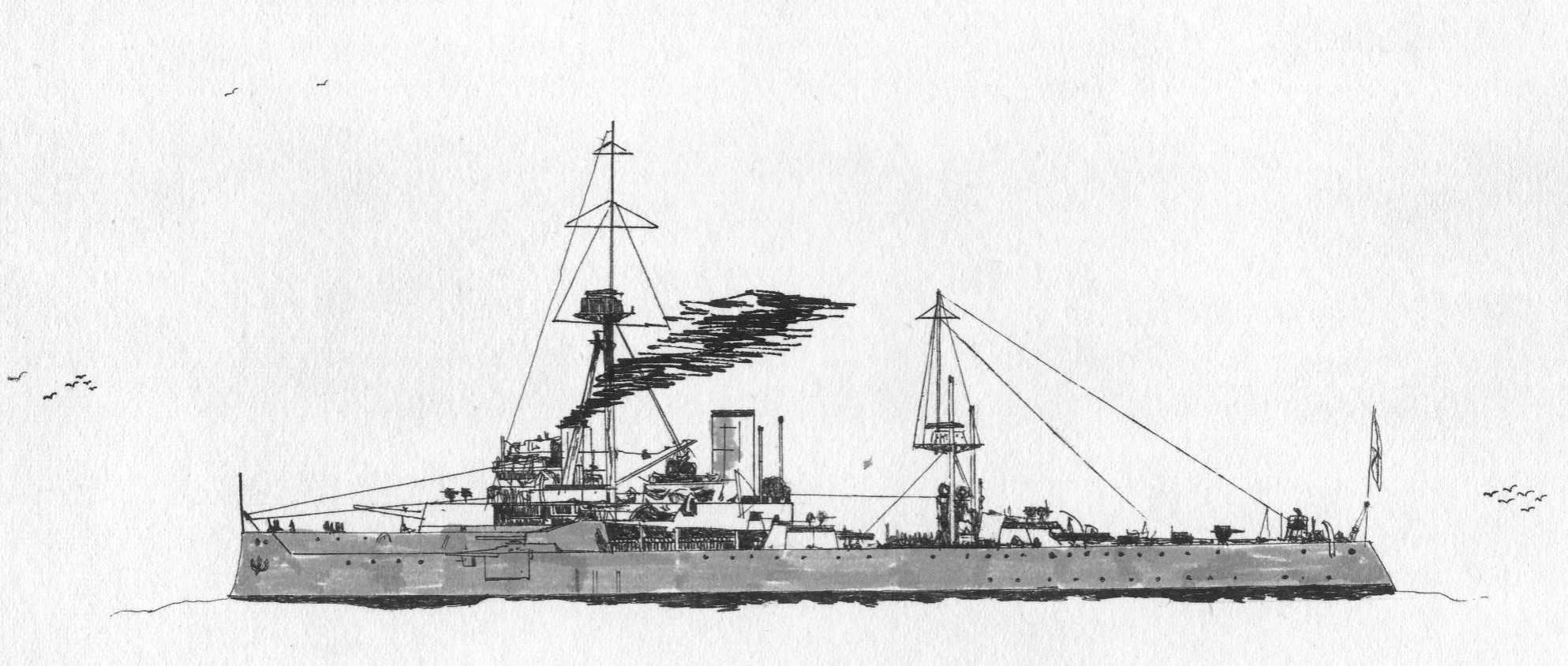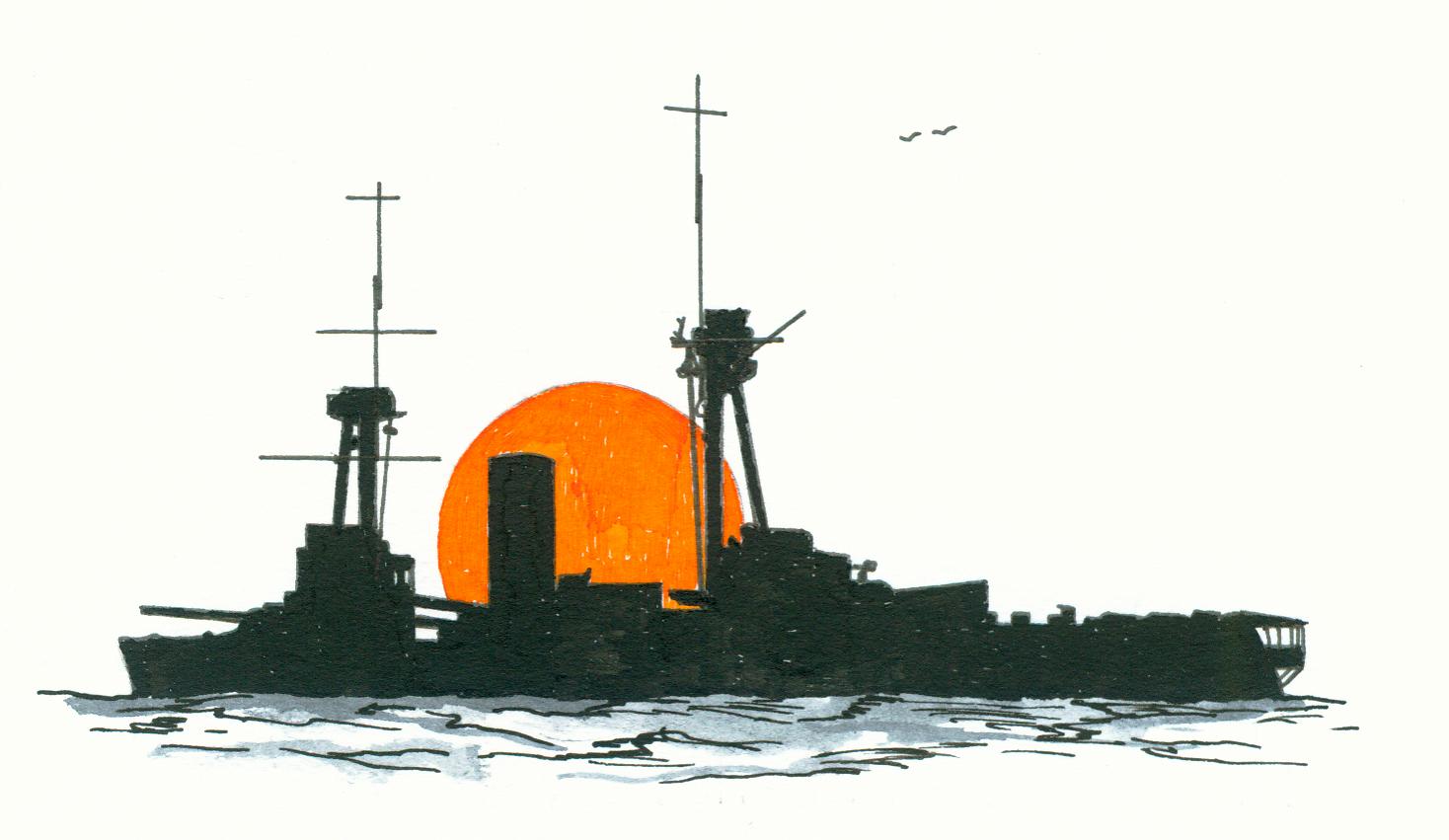Dutch De Zeven Provinciën
British HMS Dreadnought
Spanish Espana-class
British Vickers design No. 694 from 1913
In the first quarter of the 20th Century was the Royal Netherlands interested in acquiring heavier artillery ships especially for the defence of the Dutch East Indies. The largest built before the First World War was the Hr.Ms. De Zeven Provinciën at the navy yard at Amsterdam between 1908-1910. Her armament consisted of 2x1-28,3cm/11.1” guns, 4x1-15cm/5.9” guns, 10x1-7,5cm/3.0”guns and 4x1-1pd guns. The displacement was 6.530 tons. The British Royal Navy built between 1905-1906 the famous battleship HMS Dreadnought of 21.060 tons deep load displacement an a main armament of 5x2-30,5cm/12” guns. This revolutionary design made the already existing battleships obsolete. The results were long discussions dealing with the questions if The Netherlands needed such large ships, what numbers and off course the needed budget. The first intention was an enlarged version of De Zeven Provinciën although also the design of the Spanish 16.190 tons full load España-class with a main armament or 8-30,5cm/12” 50 cal guns is considered to be an option. Between 1912-1914 were 11 shipyards abroad asked for tenders; it was yet impossible to built such ships in the Netherlands.(1) At one time is even spoken of 9 of such ships. The outbreak of the First World War in 1914 prevented the start of the building of the first Dutch dreadnought in end December. Among the 11 shipyards was also the British firm Vickers Ltd., Barrow-in Furness, England included. A table supplies details of several designs including the No. 607 of which a more detailed design is preserved. It’s not clear if the other designs were for the Dutch market and/or other navies.
Displacement 13.600 tons and as dimensions 420 (between
perpendiculars) x 80 (extreme) x 24.6 x
40 (depth) feet. Armour consisted of a 4” (160 lbs/square feet, fore and aft)-9”
(360lbs/square feet, amidships) thick waterline belt 6’6” deep and carried
throughout it length from 4’ below the normal load waterline to 2’6” above.
Lower edge of the 9” tapered to 5” from 2’ below the normal load waterline. Waterline
aft completed by an armoured bulkhead with a thickness of 4”. Intermediate belt
extend from the top of the waterline belt to the main deck and in fore and aft
direction from the aftermost barbette screen bulkhead to the stem. Amidships if
way of the machinery spaces and magazines 6” (240 lbs/square feet) and forward
of this reduced to 4” (160lbs/square feet) and 3” (120 lbs/square feet). Citadel,
battery, barbettes and conning tower protected by respectively 6”, 4”, 9” and
9”thick armour. The armament consisted of Vickers 4x2-13.5” 45 cal breach
loading guns, 16-4” 50cal quick firing guns, 2-3pd quick firing guns, 4
machineguns and 2-21” submerged broadside torpedo tubes. She carried 8
torpedoes, 80-13.5” rounds for each gun, 200-4” rounds for each guns, 500-3pd
round for each guns and 10.000 rounds for each machinegun. The 13.5 guns were
double mounted in barbettes and gun houses worked by hydraulic gear on the
upper deck 4 forward and 4 aft of the centre line. Two pairs super firing over
the other 2 pairs. Height fore guns 22” of the axes and on 31’6” above normal
load waterline. Fire angle from right ahead to 60 degrees abaft the beam on
each broadside. 4” Guns on tween deck mounting with shields placed behind the
4” armour of the citadel on the main deck. 8-4”guns at the ends of the citadel
fire angle from right ahead or right aft to 40 degrees abaft or the before the
beam. Machinery consisted of Parsons turbines and water tube boilers. Trial
speed 18 knots. Fuel oil bunker normal capacity 450 tons. Building costs
1.280.134 pound sterling. Crew numbered 700 men.
Source
Nederlands Instituut voor Militaire Historie (NIMH),
The Hague, Netherlands, losse aanwinsten inventory number 1337.
Note
1. See for instance
“Een Zeeuwse dreadnought 1912-1914?”, Den Spiegel, January 2014, p.14-19. 



